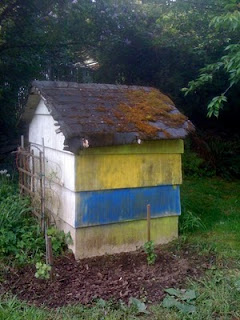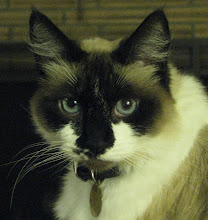Thanks to the towering Port Orford cedar in the southeast corner of our lot, and the mature pink chestnut that dominates the west side, our back yard has grown noticeably shadier in the five years we've lived here. Any given spot in the narrow herb and veggie bed along the south side of the house receives no more than a couple of hours of direct sunlight a day. The yellow climbing rose in the middle of that space is flourishing; it's as tall as the eaves this season, and casts its own shadow on the garden below.

The herbs, most of which are perennials, do fine here. We have more sage and oregano, especially, than we can use. This year I direct-sowed cool weather crops -- lettuces, spinach, beets and snap peas -- from seed in mid-March, and again in early May. I got poor germination from everything but the peas and, so far, very slow growth. It's been a cold, late spring. I'll go back to starts (a.k.a. plantlets) next year, or bite the bullet and find the room/rig up the lighting to start my seeds indoors. I've done it before; I've just gotten lazy (and space has gotten tighter) in recent years.
Given its iffy exposure, it's amazing that I even attempted to grow tomatoes in our backyard. The first year, I had
beginner's luck with Brandywines and a couple of other heirlooms. Since then, I've had lackluster results, except from the cherry-type varieties. In retrospect, I realized that my veggie patch has grown progressively more shady over the years; do you think there might be a correlation?
Meanwhile, out front, the sweet gums on our parking strip
dropped a few large limbs in various winter storms. Apart from the hassle of having to Deal With It, these losses were not unwelcome. They meant not only less raking, but
more sun on the front garden. Last winter also vanquished several large ornamentals, opening up plantable real estate here and there. In early spring I watched the progress of light and shade across the garden, and realized: the tomatoes go in front this year. That's where the sun is; duh. Sometimes I'm a slow learner.

So here's what I'm trying for Tomato Season 2010: The huge black pot in the driveway contains three cherry-types: Sweet Million, Oregon Cherry, and Sun Gold. At this point the tomato cages look delusionally optimistic. The pot itself once housed a camellia that graced the back patio when we bought the house in 2005. I think it was placed there by the sellers to hide a crack in the cement. After we moved in, I transplanted the camellia to the west end of the yard, where it seems happy next to my
Marathon Conifer, and stashed the empty pot next to the compost bin. (Sometimes it pays to hang onto stuff.) The pot should be adequate, I'm thinking, for three healthy, mature tomato plants. I set it on a wheeled stand (guaranteed to hold up to 500 pounds) so I can move it around, if necessary, to maximize solar exposure. At this point in the season, the driveway is sunny all day.

On impulse, I bought an EarthBox (tm) on my most recent nursery shopping frenzy. I'm sort of embarrassed about this. It's an expensive piece of plastic, albeit sturdy and well-made. It comes with bags of soil amendments, a watering and drainage system, and an elastic-edged rectangle of black plastic mulch that stretches over the top of the bin like a fitted bedsheet. Just add dirt, seedlings and water, and stand back for explosive growth. We'll see. It's on wheelies, too, in case I need to move it. On the far end, above, is a Siletz tomato, on the near side, a Stupice. Both are reputed to do well in the Willamette Valley. The latter looks a little peaked, though it is already bearing (a) fruit and might just be stressed by the rigors of early pregnancy.
I bought all five plants I've mentioned as seedlings from Territorial Seed Company, which has a fine reputation for breeding and selling varieties that do well in the Northwest. They were spendy ($5 and change each, once you factor in shipping); for the price, I was hoping they'd be larger. If they do well I'll hunt around at local nurseries and buy them in person next year.

I plunked a second Sun Gold, purchased at a neighborhood plant sale ($2 for a seedling already almost a foot tall), directly into the garden. We'll see how it does relative to the one in the big black container. A few feet to the east of that, I found room for another, smaller pot. This one (above) is a Black Krim, Russian in heritage and reputed to do well in our relatively short growing season.

A couple of weeks ago I started zucchini and yellow summer squash seeds (also from Territorial) inside, in the dressing-room garden window. They look vigorous and eager to get growin'. My plan is to colonize some of the bare spots in the front garden left vacant by my deceased euphorbia, kniphofia, ornamental grasses and the few not-hardy-enough phormiums that survived the snows of '08-'09 but succumbed to this past December's dry, windy arctic chill. Maybe I'll plant some squash among the irises on the west side of the house, which gets some afternoon sun. I'll have enough seedlings left, I'm sure, to plunk a few in the so-called veggie bed in my ever-more-challenging backyard.























































